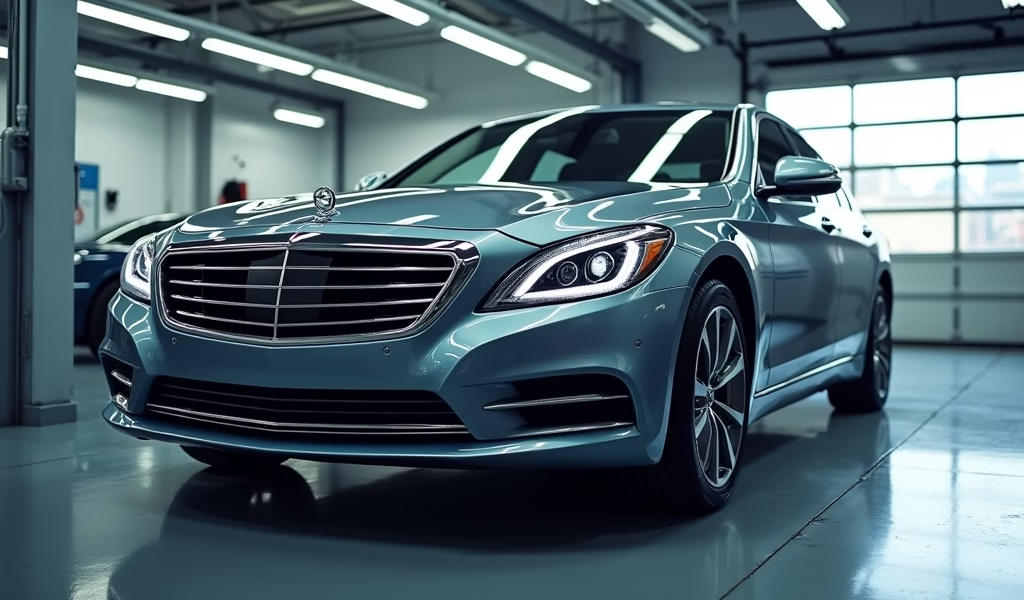Overview
This article details essential preventive maintenance strategies for American vehicles, covering oil changes, tire care, electrical systems, cooling, brakes, transmission, and seasonal maintenance to maximize performance and longevity. It emphasizes how proper maintenance can extend vehicle lifespan by up to 50%, allowing American cars to regularly surpass 200,000 miles while preserving their distinctive performance characteristics.
Table of Contents
- American Automotive Excellence: A Tradition of Quality
- Preventive Care Fundamentals: Why It Matters
- Oil Changes the American Way: Going Beyond the Basics
- Tire Care for American Vehicles: Maximizing Performance
- Electrical Systems in American Cars: Preventing Common Issues
- Cooling System Maintenance: Avoiding Overheating Disasters
- Brake System Care: Safety First Approach
- Transmission Maintenance for American Models: Extending Lifespan
- Seasonal Maintenance Tips for American-Made Vehicles
- DIY vs. Professional Service: Making the Right Choice
- Conclusion: Keeping American Excellence on the Road
- Frequently Asked Questions
American Automotive Excellence: A Tradition of Quality
When it comes to the best American made cars, we’re talking about more than just vehicles—we’re discussing rolling pieces of national heritage. From the assembly lines of Detroit to the innovative factories across the heartland, American automobiles represent a century-plus tradition of engineering prowess, innovation, and durability.
As a mechanic with over 20 years under my belt, I’ve watched these magnificent machines evolve while maintaining that distinctive American character—bold, powerful, and increasingly refined. The secret to keeping these domestic champions running at peak performance isn’t mysterious; it’s preventive care, pure and simple.
Think of your American-made vehicle as an athlete—even the most naturally gifted need consistent training and care to perform at their best. The same principle applies to your Ford, Chevrolet, Jeep, or Tesla (yes, American innovation now extends to electric vehicles too!).
Preventive Care Fundamentals: Why It Matters
Preventive maintenance isn’t just about avoiding breakdowns—it’s about preserving the very essence of what makes American cars special. That distinctive rumble of a Mustang’s V8 or the confident handling of a Cadillac doesn’t happen by accident.
Did you know that regular preventive maintenance can extend your vehicle’s lifespan by up to 50%? This isn’t just mechanic folklore; it’s backed by data from Consumer Reports showing vehicles that receive consistent care routinely surpass 200,000 miles. That’s the difference between trading in at 100,000 miles or enjoying another decade of reliable service.
The cornerstone of preventive care is developing a relationship with your vehicle. Listen to it. Feel how it drives. Notice changes in performance. American cars are particularly communicative—they’ll tell you when something’s not right, but only if you’re paying attention.
Oil Changes the American Way: Going Beyond the Basics

You’ve heard it before—change your oil regularly. But for American-made vehicles, particularly those powerful V6 and V8 engines that define many domestic models, oil changes deserve special attention.
Here’s something many owners don’t realize: American engines often benefit from synthetic oil blends specifically formulated for their unique characteristics. While European manufacturers may specify certain oil weights, American engines—particularly those in performance models like the Corvette or Challenger—often perform optimally with oils designed to handle higher temperatures and provide superior protection during cold starts.
For modern American cars with turbocharged engines (like Ford’s EcoBoost lineup), the oil change interval might need adjustment depending on your driving habits. Heavy towing, frequent short trips, or spirited driving might necessitate more frequent changes than the standard 5,000-7,500 miles many manufacturers recommend.
When changing oil, don’t overlook the filter quality. American engines typically move significant oil volume, putting greater demands on filtration. Investing in premium filters can prevent microscopic contaminants from causing premature wear on precision engine components.
Tire Care for American Vehicles: Maximizing Performance
American vehicles—from muscular performance cars to rugged trucks and SUVs—place unique demands on their tires. Their often heavier weight and higher torque output mean proper tire maintenance isn’t just about longevity; it’s about safety and performance too.
Rotation patterns matter more than you might think. For American rear-wheel-drive vehicles (think Chargers, Camaros, and F-150s), the forward-cross rotation pattern typically provides the most even wear. This isn’t just mechanic mumbo-jumbo—proper rotation can extend tire life by up to 10,000 miles.
Here’s a game-changing tip many owners miss: American vehicles often benefit from slightly higher tire pressure than European counterparts due to their weight characteristics. Check your door jamb sticker, but consider going 1-2 PSI above the minimum recommended pressure (while staying below maximum) for improved fuel economy without sacrificing ride quality.
Don’t forget seasonal adjustments. In colder regions, tire pressure drops approximately 1 PSI for every 10-degree Fahrenheit temperature decrease. For those all-American trucks and SUVs relied upon during harsh winters, this can mean significant pressure changes that affect handling and traction when you need them most.
Electrical Systems in American Cars: Preventing Common Issues
The days when American cars had simple electrical systems are long gone. Today’s domestic vehicles feature sophisticated electronics that rival aerospace technology, controlling everything from engine timing to cabin comfort.
Battery maintenance takes on special importance in American vehicles, particularly in models with extensive electronic features. While most batteries last 3-5 years, proactive testing at the 2.5-year mark can prevent that dreaded no-start situation. A healthy battery should read 12.6 volts or more when fully charged and rested.
Alternator health is crucial yet often overlooked. Many American makes—particularly Chrysler products—can exhibit subtle warning signs of alternator failure before dashboard lights appear. Headlights that dim slightly at idle but brighten when revving the engine often indicate an alternator beginning to fail.
Perhaps the most valuable preventive measure for modern American car electrical systems costs nothing but attention: monitoring for software updates. Manufacturers like Ford and GM regularly release updates that improve system function, often resolving minor glitches before they become noticeable problems. Most dealers will check for and install these updates during regular service, but it never hurts to ask specifically.
Cooling System Maintenance: Avoiding Overheating Disasters

American engines, with their traditionally larger displacements and higher power outputs, generate significant heat that must be efficiently managed. A well-maintained cooling system isn’t just about preventing overheating—it’s about optimizing performance and longevity.
Here’s something that surprises many owners: coolant type matters significantly in American vehicles. While the old green ethylene glycol served well for decades, modern American cars often specify particular coolant formulations—from Dex-Cool in GM products to specific formulations for Ford and Chrysler vehicles. Using the wrong type can lead to premature water pump failure, heater core issues, or even radiator damage.
The radiator cap—that humble $10 part—plays a crucial role in maintaining proper system pressure. A failing cap won’t trigger any warning lights but can cause overheating issues that might be misdiagnosed as more serious problems. Testing or replacing this component every two coolant changes is cheap insurance against bigger troubles.
Perhaps the most overlooked cooling system component is the thermostat. This simple device regulates engine operating temperature, and a stuck-open thermostat can prevent an engine from reaching optimal operating temperature—leading to increased fuel consumption and accelerated wear. If your American vehicle takes longer than normal to reach operating temperature (typically 3-5 minutes in moderate weather), a thermostat replacement might be in order.
Brake System Care: Safety First Approach
American vehicles—especially larger SUVs and trucks—place substantial demands on their braking systems. Their weight and performance capabilities mean brake maintenance isn’t just about safety; it’s about preserving the driving character these vehicles are known for.
The fluid flush revelation: While most owners know to replace brake pads, many overlook the importance of periodic brake fluid replacement. Brake fluid is hygroscopic—it absorbs moisture from the air, which lowers its boiling point and introduces corrosion risks to internal components. For American vehicles driven in humid climates, a flush every two years can prevent costly caliper and master cylinder replacements.
Listen to your brakes—they’re talking! American vehicles often use different brake materials than their import counterparts. The semi-metallic pads common in domestic models may produce more dust and occasional noise but typically offer superior high-temperature performance and durability—essential for vehicles that might tow or carry heavy loads.
Here’s a pro tip that could save you hundreds: when replacing brake pads on American vehicles, particularly performance models like Mustangs or Camaros, consider upgrading to ceramic pads. They produce less dust, create less noise, and often provide improved pedal feel without sacrificing stopping power under normal driving conditions.
Transmission Maintenance for American Models: Extending Lifespan
Transmissions in best American cars have evolved dramatically, from the robust but simple 3-speeds of yesteryear to today’s sophisticated 8, 9, and 10-speed automatics. Preventive care approaches need to evolve accordingly.
The most valuable transmission maintenance tip I can offer: ignore the “lifetime fluid” myth. No transmission fluid truly lasts the vehicle’s lifetime. For American automatics—particularly those in vehicles used for towing—changing fluid every 50,000-60,000 miles can double transmission lifespan. This is especially true for the ZF-derived 8 and 10-speed transmissions now common in Ford and GM products.
Temperature is the enemy of transmission longevity. For American trucks and SUVs used for towing, an auxiliary transmission cooler is perhaps the wisest preventive investment possible. It’s not uncommon to see properly maintained, cooler-equipped transmissions surpass 200,000 miles without internal work.
Pay attention to shift quality changes. American transmissions are typically programmed to provide smooth, almost imperceptible shifts. Any noticeable change—whether harsh engagement, delayed response, or unusual sounds—warrants investigation before minor issues become major repairs.
Seasonal Maintenance Tips for American-Made Vehicles
American cars are driven across wildly varying climate conditions, from Arizona deserts to Minnesota winters. Adapting your maintenance approach seasonally can dramatically improve reliability and performance.
Winter preparation goes beyond antifreeze. For American vehicles with their typically heavier weight, winter tires make a dramatic difference in cold-weather handling—even for AWD models. The rubber compounds in all-season tires begin to harden around 45°F, while winter-specific tires maintain flexibility and grip in much colder conditions. According to independent testing by Tire Rack, this can reduce stopping distances by up to 30% on snow and ice.
Summer heat demands attention to cooling and air conditioning systems. American cars with their spacious interiors place significant demands on A/C systems. Before hot weather hits, have the system pressure tested and refrigerant levels checked. A properly functioning A/C system not only improves comfort but reduces driver fatigue—a genuine safety concern.
Spring and fall present perfect opportunities for undercarriage inspection and protection. American vehicles driven in areas using road salt benefit enormously from bi-annual undercarriage cleaning and protection. This simple step can prevent premature rust in frame components, brake lines, and exhaust systems.
DIY vs. Professional Service: Making the Right Choice
American cars have traditionally been DIY-friendly, with accessible components and straightforward designs. While modern vehicles have grown more complex, there remains a sweet spot of maintenance tasks perfectly suited for owner attention.
DIY-friendly tasks for American vehicles include: fluid level checks, air filter replacement, wiper blade changes, battery maintenance, and tire pressure monitoring. These simple procedures require minimal tools but deliver significant preventive benefits.
Leave to the professionals: anything involving safety systems, complex electronics, or specialized tools. Modern American vehicles integrate numerous computer modules that require proper scanning equipment for diagnosis. Attempting DIY repairs on these systems can lead to costly complications.
The hybrid approach often works best: handle routine inspections and simple maintenance yourself, while developing a relationship with a trusted mechanic experienced with American brands for more complex procedures. This balanced strategy maximizes both savings and reliability.
Conclusion: Keeping American Excellence on the Road
Preventive care for the best American made cars isn’t just about maintenance—it’s about preserving a piece of automotive heritage. These vehicles represent generations of engineering evolution, from muscle cars to modern electric innovations, all sharing that distinctive American character.
By understanding the unique needs of American vehicles—from their powerful engines to their robust transmissions—owners can enjoy exceptional reliability while maximizing their investment. The right preventive approach transforms these cars from mere transportation into long-term companions.
Remember that American vehicles respond remarkably well to consistent, thoughtful care. They’re designed to be driven, enjoyed, and maintained—not babied or neglected. With the right preventive approach, that Chevy, Ford, or Jeep in your driveway has the potential to deliver hundreds of thousands of miles of faithful service.
Ready to give your American-made vehicle the care it deserves? Explore our detailed maintenance guides, find certified mechanics specializing in domestic brands, or learn more about model-specific preventive strategies at Knows Your Car. Your vehicle—and your wallet—will thank you for the attention.
Frequently Asked Questions
What makes American cars different from imports in terms of maintenance needs?
American vehicles typically feature larger engines and more robust components designed for higher torque and towing capacities. They often require specific fluids formulated for their unique characteristics and may benefit from slightly different maintenance intervals than their import counterparts.
How often should I change the oil in my American-made car?
Most modern American vehicles recommend oil changes between 5,000-7,500 miles with synthetic oil. However, if you frequently tow, drive in extreme temperatures, or make mostly short trips, consider shortening this interval to 3,000-5,000 miles.
Are American cars more expensive to maintain than foreign vehicles?
Not necessarily. While parts for certain premium American models may cost more, mainstream American vehicles typically feature widely available, reasonably priced components. Labor costs are often lower due to more straightforward design and better service documentation.
Which American car brands have the best reliability ratings?
According to recent reliability studies, Buick consistently ranks among the most reliable American brands, followed closely by Ford and Chevrolet in many segments. Tesla leads in the electric vehicle category despite being a relatively new manufacturer.
How long can American-made cars last with proper maintenance?
With diligent preventive maintenance, many American vehicles easily reach 200,000-300,000 miles. American trucks and SUVs are particularly known for longevity, with many Ford F-Series and Chevrolet Silverados exceeding 300,000 miles when properly maintained.

